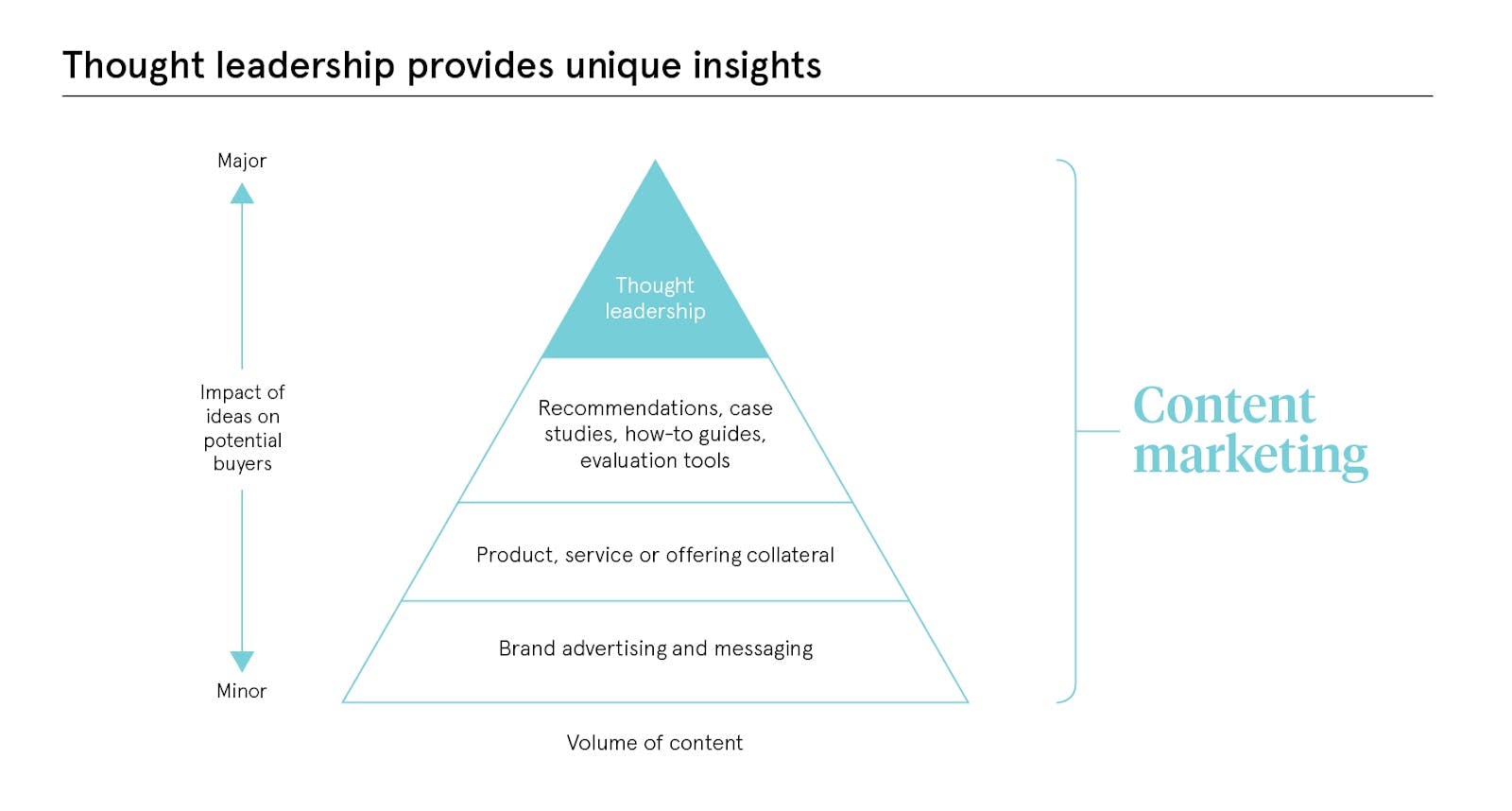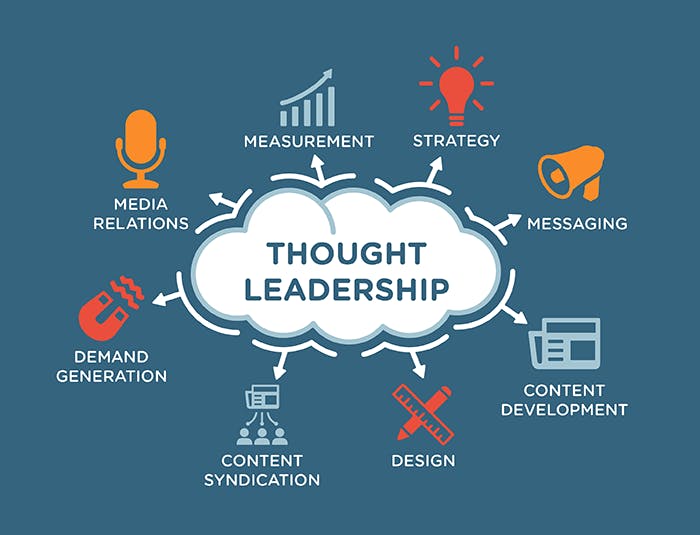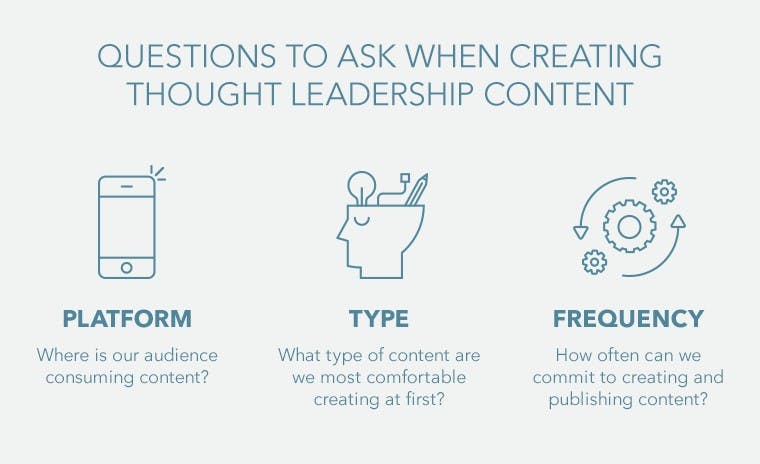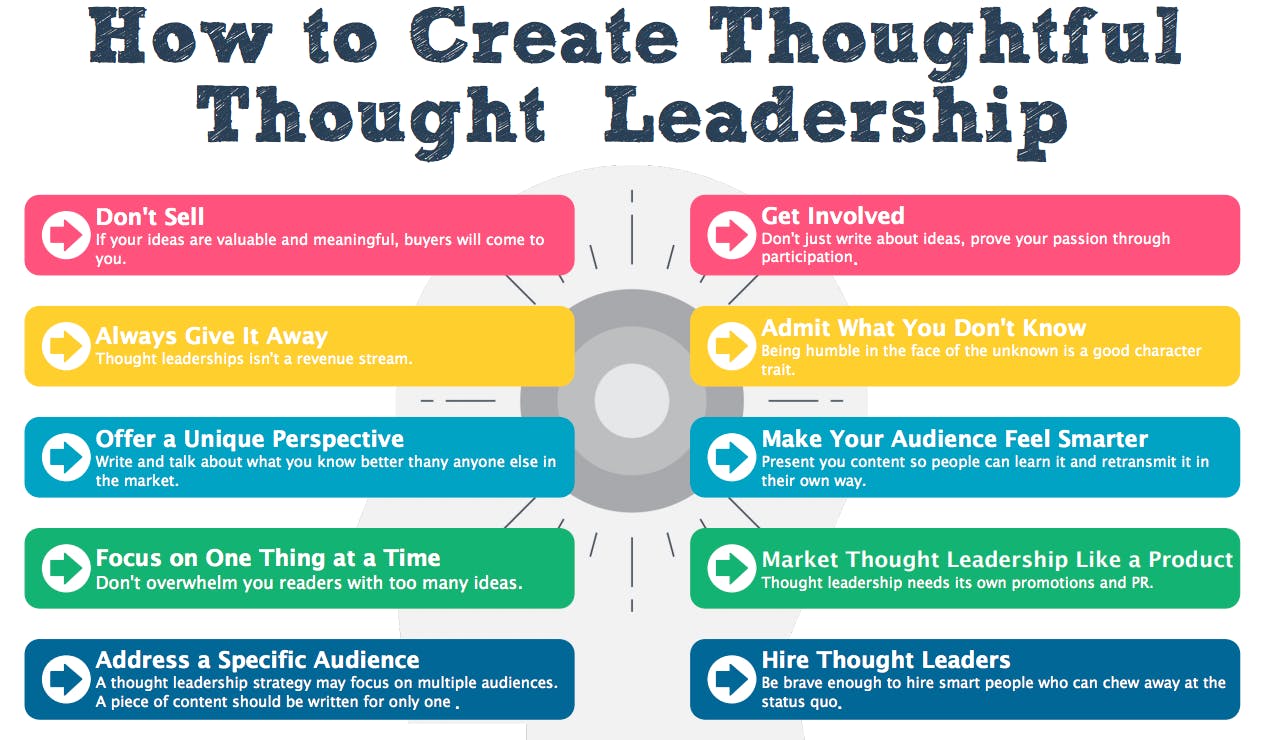Thought Leadership Explained: Strategy and Examples
Mar 19th, 2024

Contents
What is thought leadership?
How to build a thought leadership strategy
Notable examples of thought leadership
Many professionals and businesses strive to achieve the status of a thought leader. Gaining recognition as a prominent authority in your field can bring many benefits for both individuals and companies. Being a thought leader provides an opportunity to build a strong personal brand and enhance professional visibility. For businesses, thought leadership can lead to increased brand authority, industry influence, and a competitive edge in attracting customers.
However, not everyone can become a thought leader, as these are special people with unique perspectives and personalities. Nevertheless, by employing effective strategies, staying dedicated, and continuously learning, you can establish yourself as a trusted source of insight and information. Whether you are a professional looking to promote your brand or a company aiming to position itself as an authority, the steps outlined in this guide will provide a roadmap for success.
What is thought leadership?
Thought leadership is a business and marketing approach that helps position individuals or companies as industry experts and authorities within a specific field. Thought leadership aims to gain influence and develop trust among target audiences. It goes beyond conventional strategies by focusing on creating and distributing valuable and insightful content that demonstrates expertise and a deep understanding of industry trends.
Thought leaders get recognized for deep knowledge, unique insights, and ability to anticipate and address challenges. Writing excellent publications, blog posts, and white papers is paramount to thought leadership success. Moreover, thought leaders frequently deliver public speeches, participate in business events, and actively network to expand their influence.

One of the key aspects of thought leadership is the ability to inspire and drive change. Thought leaders are not merely experts; they are visionaries who can articulate a compelling narrative about the future of their industry. By doing so, they attract followers and create a community of individuals who look to them for guidance and inspiration.
Thought leadership is a dynamic and evolving process that encourages meaningful dialogue and helps shape the direction of future developments. Ultimately, it's about being at the forefront of innovation and influencing the direction of the industry.
Once you are familiar with the idea of thought leadership, the next crucial step is to develop a strategy that effectively establishes and enhances your position as a thought leader.
How to build a thought leadership strategy
Now, we will provide a detailed plan to help you establish yourself or your organization as an influential voice in your industry. From identifying your objectives to staying informed and adaptive in a dynamic landscape, each step plays a crucial role in creating a compelling and impactful thought leadership strategy.
Step 1. Specify your objectives
Begin by clearly identifying your goals for thought leadership. Knowing your goals will shape the entire strategy. For example, suppose your objective is to position yourself as an expert in emerging technologies. In that case, your content and engagement strategies will differ from those aimed at leadership in sustainable business practices. Furthermore, you can only track your progress if you have specific goals other than getting published in reputable journals.
Start by asking yourself fundamental questions: What specific impact do you want to make in your industry? Are you seeking to establish yourself as an expert in a particular niche, drive innovation, or perhaps elevate brand awareness? What is more, your objectives should align with your personal or organizational values, mission, and long-term plans. For example, if your company prioritizes environmental protection, your thought leadership objectives might focus on promoting eco-friendly practices within your industry.

Consider the specific challenges and opportunities within your niche as you define your objectives. Are there gaps in knowledge that you can fill? Are there emerging trends that you want to be at the forefront of? Your thought leadership objectives should not only reflect your expertise but also address the current needs and concerns of your audience, positioning you as a relevant and influential figure in your field.
Step 2. Identify your audience and niche
Knowing your audience is crucial for effective thought leadership. Identify the specific demographic and professional characteristics of the audience you want to engage. Consider these people’s motivations, interests, and pain points. To get an idea of this, check social media platforms or conduct interviews with your followers.
Then, choose a niche within your industry where your expertise aligns with your target audience's needs. Don’t try to be a thought leader in every aspect of your industry. Instead, focus on your area of competence and consistently emphasize that message. It is better to delve deeply into several specific topics than to cover a wide range of related subjects.
In addition, it is critical to reassess your target audience and niche market continuously. Industries evolve, and so do audience preferences. Staying attuned to these changes allows you to adapt your strategy effectively and remain relevant in the ever-shifting landscape of thought leadership.
Step 3. Develop high-quality content
Content lies at the heart of thought leadership. Create social media posts and articles that demonstrate your expertise and provide real value to your audience. Consider employing a variety of content formats to cater to different audience’s preferences. It can include blog posts, articles, white papers, podcasts, videos, and infographics. Each format offers a unique way to convey information and engage your audience.
Furthermore, thought leadership content should convey your extraordinary perspective backed by thorough research and real-world experience. Share your insights, lessons learned, and success stories. This authenticity fosters trust with your audience and distinguishes your publications from generic industry commentary.

Encourage interaction and feedback from your audience. Replying to comments and participating in discussions develops a sense of community and enhances the overall influence of your thought leadership efforts. In addition, establish a content calendar to maintain a regular schedule of publications. This consistency not only engages your audience but also demonstrates that you are actively contributing to the industry dialogue.
Step 4. Build an online presence
Building a robust online presence is essential for strengthening your thought leadership. Use platforms like LinkedIn, Twitter, and industry forums to share your insights and connect with your audience. Consistent and strategic use of social media can help establish you as a recognizable figure in your industry and drive traffic to your thought leadership hub, whether it's your website, blog, or YouTube channel.
Actively seek opportunities for media coverage and interviews. Being featured in reputable publications or participating in industry-specific events can significantly improve your online presence. Join thought leadership platforms such as Medium and Substack, Forbes, or niche media publications that accept guest contributions.
Optimize your website to increase visibility. Make sure it demonstrates your biography, accomplishments, and key insights. Create a blog on your website to regularly share industry trends and inspiring content. In addition, ensure your online presence reflects a cohesive and professional brand image. Use a consistent color scheme, logo, and messaging across all platforms. A strong and recognizable brand enhances your credibility.

Step 5. Network and collaborate
Networking is a powerful tool for thought leaders. Attend industry conferences, webinars, and events to connect with like-minded experts. Actively seek opportunities for collaboration, such as participating in panel discussions or hosting joint webinars. Regularly contribute to industry publications, blogs, or podcasts to further establish your presence within the professional community.
Use online networking platforms to connect with specialists in your industry. Join relevant groups and take part in discussions to establish yourself as a thought leader within these online communities. Engage with your connections by sharing your insights and supporting their content.
Embrace mentorship as a form of collaboration. Whether you are seeking guidance from established thought leaders or mentoring emerging professionals in your field, these relationships contribute to the collective growth and knowledge sharing within your industry. Moreover, mentorship enhances your reputation as a thought leader while providing valuable learning experiences for both parties involved.
Step 6. Measure and analyze performance
Regularly assess the performance of your strategy to ensure it aligns with your objectives. Utilize analytics tools to track KPIs across various marketing channels. For your website, monitor metrics such as traffic, page views, and bounce rates. Analyze which pieces of content are most popular and resonate with your audience. On social media, track engagement metrics, follower growth, and the reach of your posts.
Set specific goals and benchmarks aligned with your thought leadership objectives. Whether it's increasing website traffic, growing your social media following, or boosting engagement, having measurable goals provides a clear roadmap for success. Regularly assess your progress against these goals, adjusting your strategy as needed to stay on course.
Implement A/B testing for your content and engagement strategies. Experiment with different content types, posting schedules, and engagement tactics to determine what yields the best results. A/B testing allows you to make knowledgeable decisions, refining your approach based on the real-time performance of different elements of your strategy.
Step 7. Stay informed about the latest trends
Continuously learn about the latest developments in your industry. Actively seek out new information through reputable sources, attend industry conferences, webinars, and workshops, and participate in relevant training programs. Regularly monitor industry trends, emerging technologies, and shifts in consumer behavior.
As new platforms and tools emerge, evaluate their relevance to your strategy. Whether it's adopting new social media platforms or incorporating virtual reality experiences, embracing technological advancements can enhance your reach and engagement with your audience.
Ask for feedback from your audience. Gather insights on the impact of your efforts, and be open to constructive criticism. Use this feedback to refine your approach. An iterative mindset allows you to experiment with new ideas, discard what doesn't work, and implement strategies that resonate with your audience.
Remember, building a strong brand is an ongoing process. Continually refine your approach based on feedback and analytics, and stay committed to providing valuable insights to your audience.
Notable examples of thought leadership
Let us explore the examples of thought leadership that have paved the way for transformative changes. We will discuss the stories and strategies of individuals and organizations that have left a mark on their industries.
Chris Voss
Chris Voss is a former FBI hostage negotiator who has gained recognition as a thought leader in the communication field. The expert shares his knowledge through a negotiation course on MasterClass. In this course, he provides practical techniques and strategies applicable not only in hostage situations but also in various aspects of everyday life, including business and personal interactions.
Voss introduces innovative communication techniques, such as tactical calibrated questions, mirroring, and labeling, as tools to build rapport and influence results. His approach challenges traditional notions of negotiation, portraying it as a collaborative process rather than a confrontational one. This perspective has influenced how individuals perceive communication and conflict resolution in professional and personal settings.
Sheryl Sandberg
Sheryl Sandberg is a thought leader in the tech industry. She is known for being a long-time COO of Meta, her advocacy of women's leadership, and her book Lean In, which encourages women to pursue their ambitions. In the book, she addresses gender inequality in the workplace and encourages women to take on leadership roles and challenge societal norms.
Moreover, Sandberg addresses issues such as the gender pay gap, lack of diversity in boardrooms, and the importance of mentorship for women in the workforce. She has participated in educational programs designed to provide people with the skills and knowledge needed for leadership roles. Sandberg's thought leadership is evident in her ongoing commitment to effecting positive change for women in the corporate world.
Simon Sinek
Simon Sinek is a thought leader on motivation. He gained popularity with his TED Talk and book Start With Why, which emphasizes the value of understanding the purpose behind actions. His philosophy focuses on the idea that great leaders inspire action by communicating their vision in a way that resonates with people. He highlights the importance of aligning values and purpose to create a sense of belonging and commitment within an organization.
In addition to Start With Why, Sinek has authored several books that describe leadership, teamwork, and personal development. His works often combine research, case studies, and practical insights, making them relevant to a wide audience. Sinek's thoughtful commentaries on leadership have influenced how individuals and organizations approach their goals.
Brené Brown
Brené Brown is a professor and author known for her work on openness, shame, and empathy. Her TED Talk, The Power of Vulnerability, went viral, leading to international recognition. Brown's strategy involves challenging societal norms around vulnerability and encouraging individuals to embrace it as a source of strength. She uses storytelling and research to connect with people on a deep, emotional level.
Brené Brown is a captivating public speaker who combines research findings with personal anecdotes and humor. Her engaging talks and presentations have made complex psychological concepts accessible to a broad audience. Moreover, her work has had a profound impact on discussions around mental health and well-being.
Thought leaders are known for shaping discussions, influencing trends, and contributing valuable insights that go beyond conventional thinking. Through their expertise, original ideas, and compelling communication, thought leaders inspire and guide others, leaving a lasting impact on their lives. To become a successful thought leader, cultivate a passion for lifelong learning, stay abreast of trends, and share your insights openly. Be a leader, not a follower.
